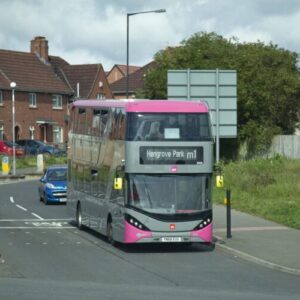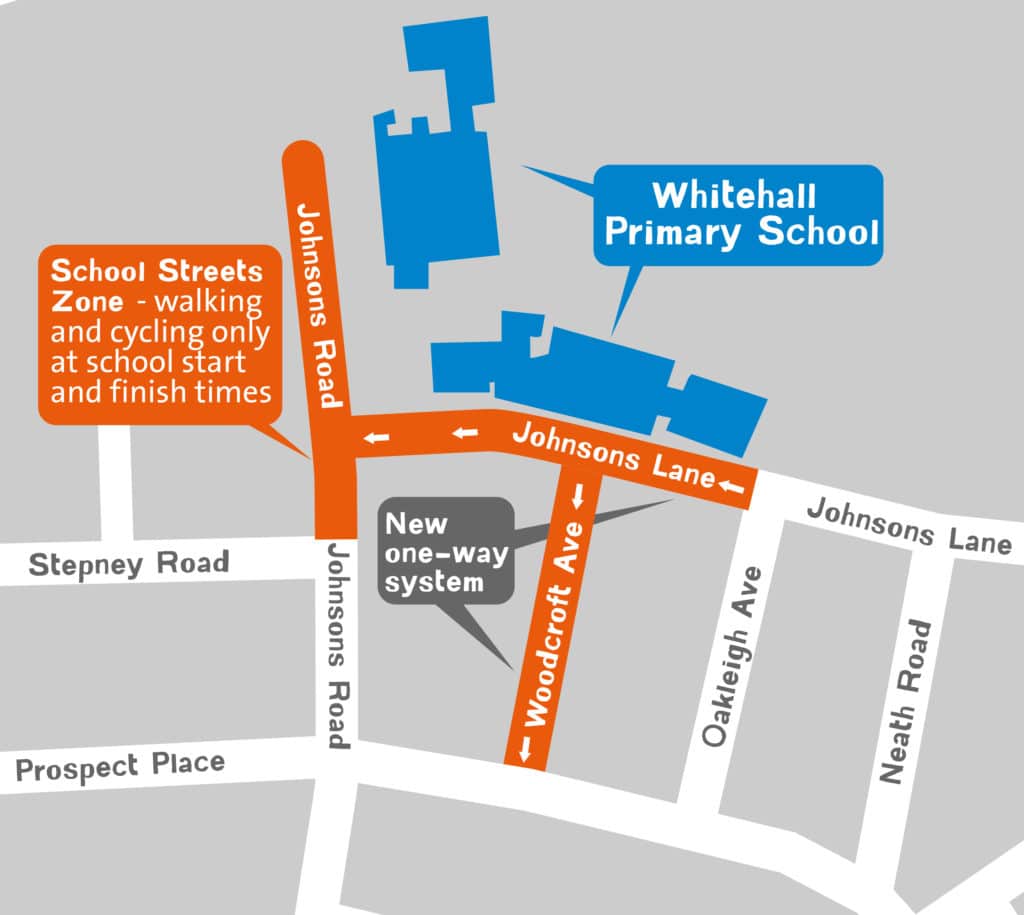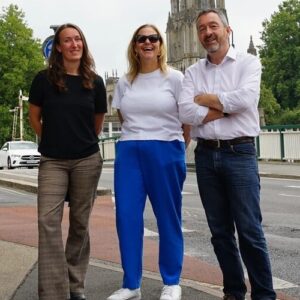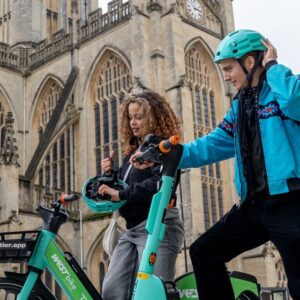
M1 metrobus route to be extended in 2026
Works to extend the popular m1 metrobus route and improve walking, wheeling and cycling infrastructure in the area are set...
As of June 2022, Bristol City Council has successfully launched the School Streets scheme with seven primary schools in the city. This was extended to Whitehall Primary school which launched on the 20th September 2022
The main aims of Bristol School Streets are to:

To reduce traffic danger and congestion in the area, Bristol City Council turned a section of Johnsons Lane, a section of Johnsons Road and Woodcroft Avenue into a walking, wheeling, cycling and scooting-only zone at school start and finish times.
There are physical barriers, managed by school staff placed at two points at the boundaries of the zone, at the junction of Johnsons Lane and Oakleigh Avenue and at the junction of Johnsons Road and Stepney Road.
The timings of the closure are between 08:30 – 09:15 in the morning and 15:10 – 15:45 in the afternoon, from Monday to Friday during term-time only.
Certain exemptions apply, including emergency services and blue badge holders. Residents and carers of residents on the street are able to apply for an access permit. (hyperlink)
To help with the closure, a new one-way has been introduced on Woodcroft Avenue going southbound, and the existing one way on Johnsons Lane was extended up to the junction with Oakleigh Avenue. Introducing a part-time one way system is considered unsafe, and so these one-ways are in use 24-hours a day, seven days a week. People travelling by cycle are exempt from this restriction.
Signs are on display at the entrance to the School Street zone, and temporary barriers will be placed on the road to help reinforce the measures. A trained member of school staff will operate the barriers.
To help with the closure, a new one-way has been introduced on Woodcroft Avenue going southbound, and the existing one way on Johnsons Lane is extended up to the junction with Oakleigh Avenue. Introducing a part-time one way system is considered unsafe, and so these one-ways will be in use 24-hours a day, seven days a week. People travelling by cycle are exempt from this restriction.
Signs will be on display at the entrance to the School Street zone, and temporary barriers will be placed on the road to help reinforce the measures. A trained member of school staff will operate the barriers, with support from Bristol City Council officers for the first two weeks.
The introduction of a one way on Woodcroft Avenue was necessary to prevent motorists travelling northbound on Woodcroft Avenue from becoming trapped at the junction with Johnsons Lane where they would meet a no-entry point. This would leave these motorists with no choice but to reverse or turn in the road to travel back down Woodcroft Avenue, thus causing a hazard.
In addition, introducing a one-way on Woodcroft Avenue reduces the number of entry points to the ‘School Street’ zone from three to two, which is expected to improve compliance and traffic circulation in the immediate area.
With the introduction of a southbound one way on Woodcroft Avenue, motorists will already be restricted from travelling eastbound on Johnsons Lane from Woodcroft Avenue to Oakleigh Avenue, and therefore it is necessary to extend the existing one-way.
The schemes is enforced by the police. The penalty for ignoring the prohibition is a fixed penalty notice. Advanced warning signs will be installed, and barriers will be placed at the entrance to the scheme, and monitored by school staff and Bristol City Council staff. All vehicles already parked in the zone before the times of operation will be able to exit without incurring a fixed penalty notice.
Residents within the School Streets zone are able to exit their road during the zone’s operational hours without requiring an access permit.
If you live in the School Street zone and require access during the times of operation, you can apply for one here.
Where possible, we encourage all motorists to avoid driving in the zone when in operation. If driving in the zone, we ask that you do so at no more than 5mph.
We hope that the proposed changes will improve the traffic conditions outside of the school gates. We understand from local people that parking at school start and finish times has been an ongoing issue and, by introducing a School Streets zone and closing the road for short periods of time, we can improve road safety and tackle congestion.
School Streets makes it easier for Blue Badge holders to access the school by reducing traffic outside the school gates. Those holding a valid Blue Badge are exempt from the restrictions but should still avoid parking on school ‘keep clear’ zigzag markings. We ask that Blue Badge holders display their Blue Badge clearly in the windscreen of their vehicle and they may be stopped and asked to confirm their details on some occasions.
We ask people with additional access requirements and those with disabilities to contact the Bristol School Streets team to discuss any personal access needs as they may be eligible for an exemption permit.
No – parents or carers dropping children at school are not eligible for an exemption, unless you or your child are a Blue Badge holder or have access needs. We are pleased that parents at our existing Bristol School Streets schools are embracing the scheme and are choosing to walk, cycle or scoot where possible.
No, they must be inside the area before it comes into operation. Only staff who have a Blue Badge are exempt.
Yes – if you are a carer who regularly supports a resident within the zone, you may be eligible for an exemption. Please visit our resident and carer permit page here, which includes details on how to apply.
Any deliveries will need to adhere to the School Street times of operation. Deliveries should be scheduled outside of closure times, where possible. During the times of operation, delivery drivers can park on surrounding streets and still make deliveries by foot. On occasions where this is not possible, for example if you’re moving home or having a large and heavy item delivered, you will be able to use the Bristol School Streets phone line to request access.
Bristol School Streets encourages and prioritises a safe environment around schools. We hope that parents and carers will support the trial by walking, cycling and scooting to school with their children.
We are aware that some will still need to drive. Where possible, please ‘Park and Stride’ or ‘Scoot from the Boot’, which means driving some of the way and walking/scooting the final 5 to10 minutes to school. It is important to be mindful of local residents and other road users by not obstructing driveways, pavements and public transport routes.
We are working with the school to promote active travel to school, which includes walking, wheeling, cycling and scooting.
Evidence suggests that where School Streets have been implemented, the result is a reduction in car use rather than displacement to surrounding streets. We are continuing to monitor the impact of the scheme now it has been implemented.
Data was collected before the scheme was implemented and is being monitored now the measures are in place. The change in traffic levels, parking surveys, how pupils travel to school and feedback from the local community are all being used to measure the success of the scheme

If you have a specific query, that has not been answered in this page, please contact us via the below email address.

Works to extend the popular m1 metrobus route and improve walking, wheeling and cycling infrastructure in the area are set...

The West of England Mayoral Combined Authority will receive more than £11.7 million in government funding to help them deliver...

Millions of passengers in the region are set to benefit from faster, cheaper and more reliable buses after the Government...

Dott, the operator of the shared e-bike and e-scooter trial service in the West of England, is expanding its service...

At Bath’s world-famous Christmas Markets, which celebrate their 25th anniversary this year with more than 250 stalls, local leaders and the...